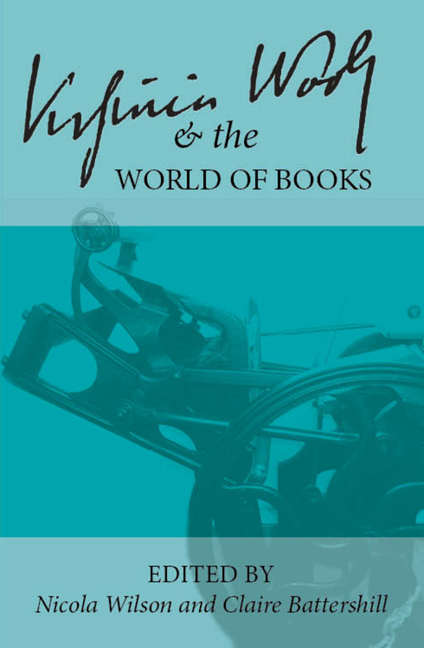 Virginia Woolf and the World of Books
Virginia Woolf and the World of Books Book contents
- Frontmatter
- Contents
- Introduction
- List of Abbreviations
- Keynote
- In the Archives
- Craftsmanship
- The Hogarth Press
- Hours in A Library
- The Art of the Book
- The Art of the Narrative
- Making New Books: Creative Approaches
- The Book in the World: Woolf's Global Reception
- Editing and Teaching Woolf
- Intertextuality
- Virginia Woolf's Appreciation for Walt Whitman's Leaves of Grass: Book Making/Reading, Intimacy, Collectivity
- Reading Intercultural, Intergenerational and Intertextual Woolf: Virginia Woolf's “The Lady in the Looking-Glass,” Oscar Wilde's “The Sphinx without a Secret,” and Lady Murasaki's Yugao
- To “write about Mrs Lindbergh”: Woolf, Flight, and Anne Morrow Lindbergh's North to the Orient
- Lives in Writing
- Notes on Contributors
Reading Intercultural, Intergenerational and Intertextual Woolf: Virginia Woolf's “The Lady in the Looking-Glass,” Oscar Wilde's “The Sphinx without a Secret,” and Lady Murasaki's Yugao
from Intertextuality
- Frontmatter
- Contents
- Introduction
- List of Abbreviations
- Keynote
- In the Archives
- Craftsmanship
- The Hogarth Press
- Hours in A Library
- The Art of the Book
- The Art of the Narrative
- Making New Books: Creative Approaches
- The Book in the World: Woolf's Global Reception
- Editing and Teaching Woolf
- Intertextuality
- Virginia Woolf's Appreciation for Walt Whitman's Leaves of Grass: Book Making/Reading, Intimacy, Collectivity
- Reading Intercultural, Intergenerational and Intertextual Woolf: Virginia Woolf's “The Lady in the Looking-Glass,” Oscar Wilde's “The Sphinx without a Secret,” and Lady Murasaki's Yugao
- To “write about Mrs Lindbergh”: Woolf, Flight, and Anne Morrow Lindbergh's North to the Orient
- Lives in Writing
- Notes on Contributors
Summary
Virginia Stephen, as a young writer, was exposed to the early twentieth-century japonisme around 1905, and became interested not only in Japan but also in Far Eastern cultures in general. She reviewed Charlotte Lorrimer's The Call of the East—a collection of Lorriemer's short stories and essays about China and Japan—for the TLS in 1907; and her meeting with Roger Fry in 1910 and her lasting friendship with him and other Bloomsbury artists and intellectuals as well as her union with Leonard Woolf matured her interest in the East. Woolf 's comradeship with Roger Fry—whose friend Kakuzo Okakura (1862–1913), with his book The Book of Tea (1906), helped him to understand Far-Eastern aesthetic and aesthetics—must be noted. Leonard Woolf worked in Sri Lanka (Ceylon) and E. M. Forster in India. Julian Bell studied Chinese and stayed in China for two years. One should invoke Woolf 's association and rivalry with Katherine Mansfield who read The Book of Tea and went to the 1910 Japan-British Exhibition, as well as with T. S. Eliot, who also read Okakura's book and studied the Noh theatre with Arthur Waley, W. B. Yeats and Ezra Pound in London in the 1910s. Virginia Woolf reviewed Waley's translation of Lady Murasaki Shikibu's The Tale of Genji for Vogue in 1925. Virginia and Leonard published William Plomer's Paper House (1929) with Fry's cover design and Sado (1931), both of which were based on Plomer's experience of staying in Japan between 1926–1929. Woolf 's interest in Far Eastern art and literature was not a short-lived intellectual flirtation: it was a lasting influence and source of inspiration, affecting the formation of her aesthetics and aesthetic as a prose artist.
This paper is an attempt to demonstrate Woolf 's aesthetic tie with the Far East by analysing her short story “The Lady in the Looking-Glass: A Reflection” (1929) and discussing textual connections chiefly between Woolf 's story, Genji, and Oscar Wilde's “The Sphinx without a Secret: An Etching” (1887). I will demonstrate that there are textual connections between Wilde's short story and Kencho Suematsu's abbreviated translation of Genji (1882), between Wilde's and Woolf 's short fiction, and between Waley's Genji and Woolf 's story. The connections between the three texts are not coincidental.
- Type
- Chapter
- Information
- Virginia Woolf and the World of BooksSelected Papers from the Twenty-seventh Annual International Conference on Virginia Woolf, pp. 260 - 267Publisher: Liverpool University PressPrint publication year: 2018
